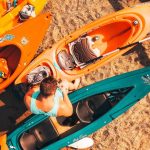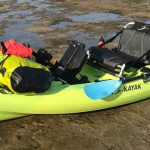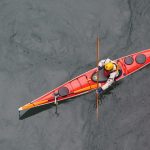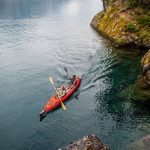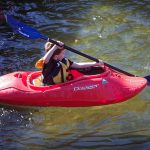In this article, we’ve got all the information you need to decide on the optimal kayak size. Discuss kayak sizes like a pro!
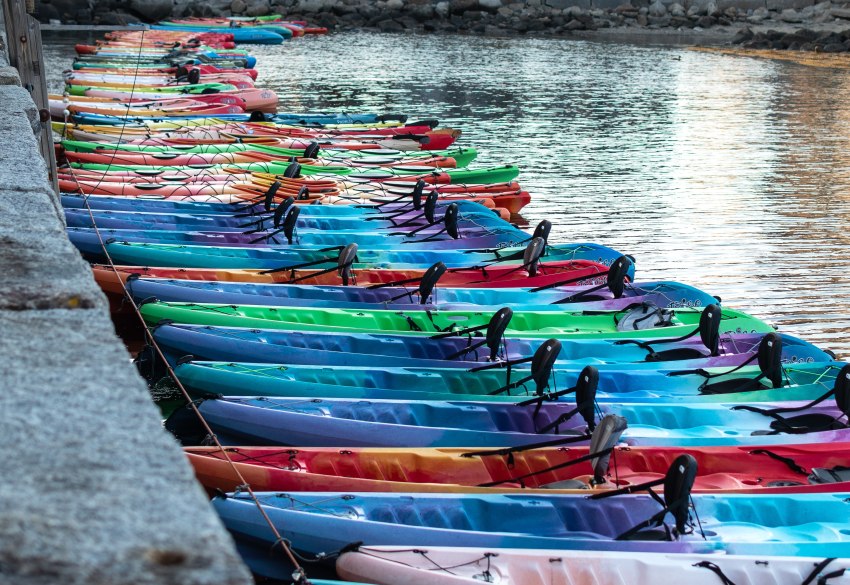
Kayaks come in so many shapes, sizes, lengths, and colors that it can be difficult to see the wood for the trees.
But why are there so many choices? How do you choose the right kayak?
This article will be your all-important guide to explaining the many different kinds of kayaks and why you would choose one over the others.
What Is a Kayak?
At the most basic level, a kayak is a small boat propelled by a double-bladed paddle. Kayaks differ from canoes, which are designed for you to kneel in and paddle with a single-bladed paddle.
The lines have blurred, though. You can now get kayak-canoe hybrids and SUP kayak hybrids.
You are not limited to paddling, either. There are pedal-powered kayaks and even kayaks with electric trolling motors or small gas outboard motors.
Why Are There Different Styles of Kayaks?
Wouldn’t it be so much easier if there was just one kayak that did everything? Unfortunately, it would probably do everything pretty badly. Different types of water demand different qualities from your kayak as well as abilities from you as a paddler.
Many things can be changed in a kayak to make it perform differently. If you’re not sure what some of the jargon means, we have a whole article on it here.
Kayak Dimensions: Small Kayaks vs. Large Kayaks
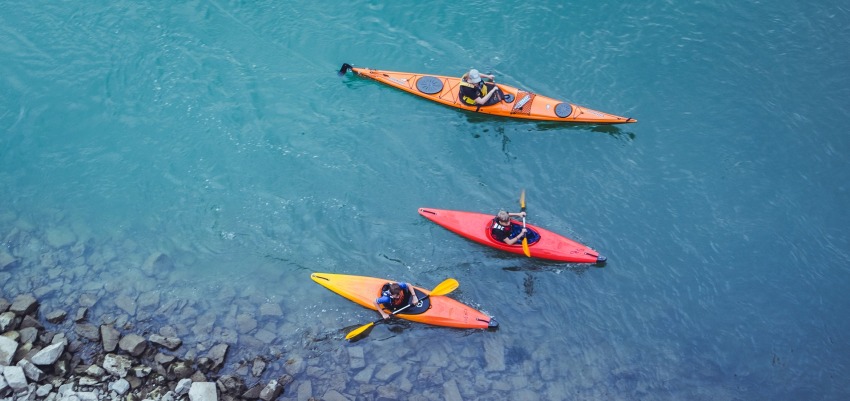
Kayak Length
Length is probably the most obvious feature of your kayak at first sight. The length of your kayak affects how fast and maneuverable your kayak is. It also has some impact on the stability of your kayak.
Long kayaks are faster, designed to cover distance more efficiently than short kayaks. These tend to be narrower than shorter kayaks and rely on length and stability.
Short kayaks are more maneuverable, usually designed for environments where making tight turns and quick moves is vital. Shorter kayaks may accelerate faster than a long kayak but will have a limited maximum speed over the water.
Kayak Width
The width of your kayak will directly impact how stable it is. This is especially true of recreational kayaks, which rely on primary stability, or stability when flat, to stay upright. In general terms, the wider your kayak is, the more stable it will be.
A wider kayak will have more surface to drag through the water though. Wide kayaks are slower and less maneuverable than narrow kayaks. It can also be difficult for paddlers with a smaller frame to reach over the side.
Volume and Capacity
The volume of a kayak is simply how much space there is inside the boat. This will directly affect the capacity of your kayak, which is how much weight the kayak can carry before it sinks.
Overloading your kayak will negatively impact on how it paddles. In order to maintain optimal performance from your kayak, you should never exceed 70% of the kayak’s upper weight limit. Remember, your paddling weight includes you, all of your equipment and any spares or specialist kit you are taking on the water with you.
If you are unsure whether your kayak will carry enough of a load, or if you are close to 70% of the weight limit, consider moving up a size.
Kayak Weight
The weight of your kayak will have some effect on it’s performance, but its more noticeable off the water. Moving and storing your kayak can be difficult. You should consider the size and weight of your kayak when thinking about how you are going to move your kayak to the water, as well as where you are going to store your boat.
If you have a small car with a lightweight roof rack, you may find that you can quickly overload it with a heavy kayak or two. Similarly, if you want to create an elaborate system to raise your kayak to the roof of your garage, a heavy boat may be dangerous.
RELATED: Best Lightweight Kayaks
Hull Shape
Kayaks come with four main hull types: flat, rounded, v-shaped, and pontoon. There’s a load of detail you can get into on this and it’s easy to geek out on hull shape. For now, we’ll just keep it simple.

Flat Hull
Flat hulled kayaks are probably the most common style. A flat hull gives your kayak stability and maneuverability. Flat hulled kayaks aren’t the fastest style, but they can plane in waves and on rivers.
Rounded Hull
Rounded hulls offer less water resistance than flat hulls and are quicker over the water. They tend to be less stable initially, but have great secondary stability, or stability when a kayak is edged or leaned into a turn.
V-Shaped Hull
V-shaped hulls are designed to track through the water and carry speed. The v-shape can act as a keel and can prevent you from slipping downwind in long crossings. V-shaped hulls feel unstable at first, relying on dynamic stability from movement, and secondary stability.
Pontoon Hull
Pontoon hulls focus solely on stability. The dual-hull design works like a catamaran. This hull shape is commonly found on angling or recreational kayaks where maximum primary stability is necessary. These boats track well but don’t turn or pick up speed effectively.
Edges, chines, and rocker are all part of the hull shape too. Chines and edges affect how much secondary stability a kayak has. Certain kayak designs rely on these edges to initiate and hold an effective turn.
The rocker profile of your kayak is the front-to-back curve of the boat. A kayak with high rocker looks banana shaped, all the way from the front to the back. Other kayaks have an upturned, or rockered, bow, with a flat stern, or varied rocker along the length of the hull.
A low rocker kayak is going to appear flatter, and will grip the water more effectively to track in the wind. A kayak with more rocker will turn more quickly and ride over waves more easily.
Kayak Type: Sit-on-Top or Sit-Inside?
You have to start somewhere when it comes to picking your perfect kayak. Deciding whether you want a sit-on-top or a sit-in kayak is as good a place as any.
Sit-on-Top Kayaks
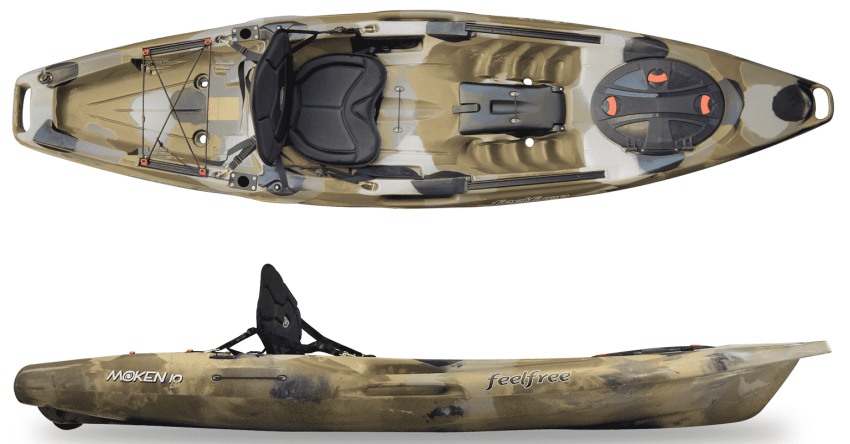
SIt-on-top kayaks have become increasingly popular in recent years. These kayaks have a sealed hull, but the top deck is open, often with a seat either molded to the top deck or fitted on bolts. Sit-on-top kayaks tend to be wider than sit-in kayaks, giving them a high level of primary stability.
This stability, combined with the fact that you don’t remain in these kayaks in the event of a capsize, has made them popular with recreational paddlers and families. They’re also easy to climb back on, and you don’t have to bail any water away in the event of a capsize.
Also check out our post on the best sit-on-top kayaks.
Sit-in Kayaks
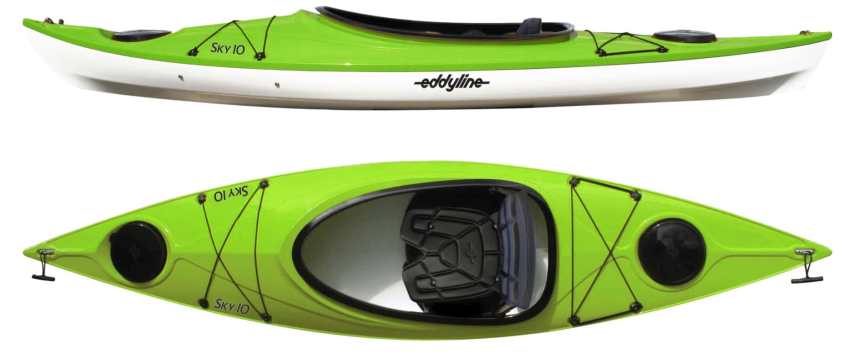
Traditional sit-in-style kayaks have a cockpit where the paddler sits. In these kayaks, the bottom half of the paddler is sheltered inside the kayak, which makes them more suitable for colder or windier environments. These kayaks are also drier paddling in waves and on rivers.
Sit-in kayaks require some capsize practice, especially if you are going to use a spray skirt on the water. These skirts prevent water from filling up your cockpit, but also keep you in the kayak if you capsize.
How many paddlers can your kayak carry?
How many paddlers do you want to take on the water? What size are your paddlers? Do you have pets you want to take kayaking?
Most styles of kayak are available in solo, tandem, or tandem+ options. Tandem and tandem+ kayaks allow you to take a partner or pet out on the water with you. Almost every style of kayak is available in tandem, from sea kayaks to whitewater kayaks.
Tandem+ kayaks vary from a two-person kayak with an extra seat, to enormous three-person options. These kayaks are suitable for families or pairs with pets they want to take out. They also suit pairs of kayakers who want to expedition and need the extra space for all of their gear.
Materials
What are kayaks made of? Different materials have different benefits and drawbacks and vary in terms of weight and strength.
Hardshell Kayaks
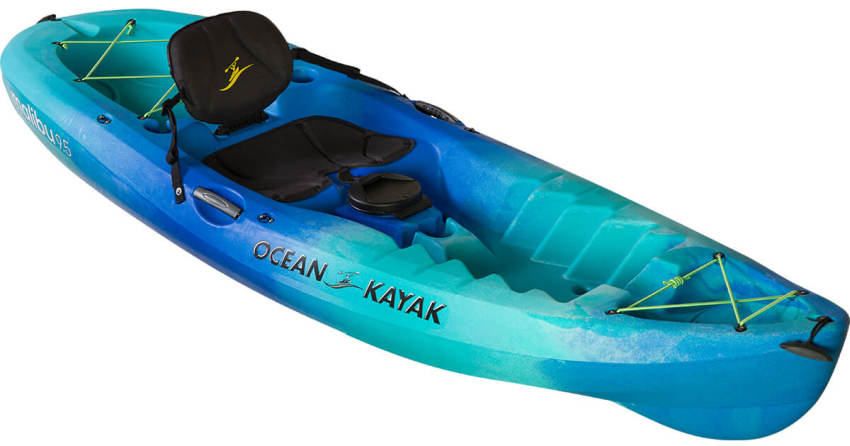
Polyethylene is the most common material kayaks are now made of. Most kayaks are either rotomolded or thermoformed from polyethylene.
Rotomolding (rotational molding) is a technology that involves pouring tiny beads of polyethylene in a mold, which is then heated and slowly rotated. The material melts and covers the inside of the mold. The mold is then cooled and taken apart to reveal the finished product. Rotomolded kayaks are very sturdy but may be heavier than thermoformed models.
Thermoforming a kayak involves vacuum forming sheets of plastic over a mold. Thermoformed kayaks are lighter and stiffer than rotomolded models and fill a gap between plastic and composite kayaks.
More affordable thermoformed kayaks are usually made from polyethylene, with higher end models using impact resistant ABS plastic. Polyethylene is heavier and more flexible than ABS, but also more durable. ABS plastic may withstand impacts, but should be stored more carefully as it degrades over time.
Plastic kayaks are the most durable on the market, capable of withstanding rocks and beach landings. They can also be customized easily, adding features either in the design process or retrospectively.
Plastic kayaks are the heaviest on the market, though they do vary in weight depending on their use and size. The cheapest kayaks on the market tend to be plastic, but these do run to nearly the most expensive, too.
Inflatable Kayaks
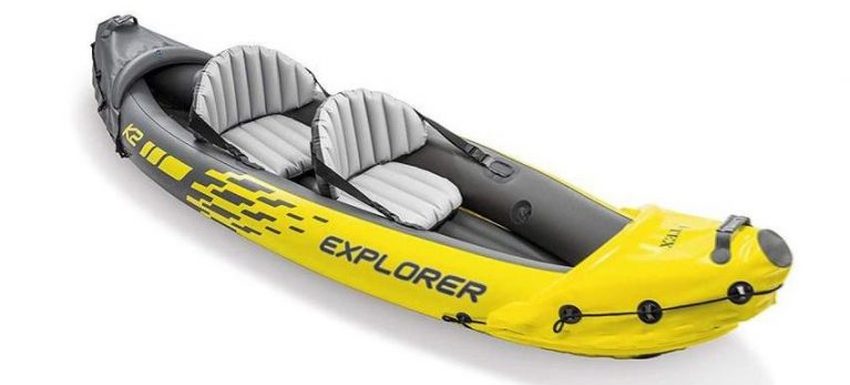
Modern inflatable kayaks are popular among recreational paddlers but have made their way into kayak fishing and whitewater kayaking too. The hard-wearing PVC design can withstand bouncing off rocks and river banks. These kayaks pack down small and stow away easily, both in the trunk of your car and in the closet at home.
Thanks to the large tubes at the sides of most inflatables, they are among the most stable kayaks available. This makes them a popular choice with families who are taking to the water for the first time, as well as kayak anglers. Inflatable fishing kayaks are often made from thicker material to withstand sharp hooks and tools.
Although they may not quite be at the same level as plastic kayaks yet, inflatables are getting better each year. Drop-stitch technology means that you can inflate some to high pressures, which gives them a similar response and feel to plastic boats. Certain designs are made to track effectively and to carry speed, though they often still struggle in the wind.
Don’t miss our roundup of the best inflatable kayaks.
Fiberglass Kayaks
FIberglass kayaks were once the pinnacle of technology. Now they tend to be reserved for high-end sea kayaks and competition craft who appreciate their stiff, responsive design.
FIberglass is extremely lightweight. It might not be as light as composite materials, but it is more affordable.
Fiberglass is brittle and doesn’t take well to rough landings or impacts on rocks. Those with the skills can easily patch and repair fiberglass kayaks though, so in theory, you can keep it going forever.
Carbon Kayaks
Carbon fiber kayaks are the lightest on the market. They are also the stiffest, most responsive material available. It also comes with the highest price tag.
Carbon kayaks are popular among top-end competitors and freestyle kayakers. These kayaks rely on environments with little to no impact. They are brittle and easy to break, as well as being difficult to repair.
Skin-on-Frame Kayaks
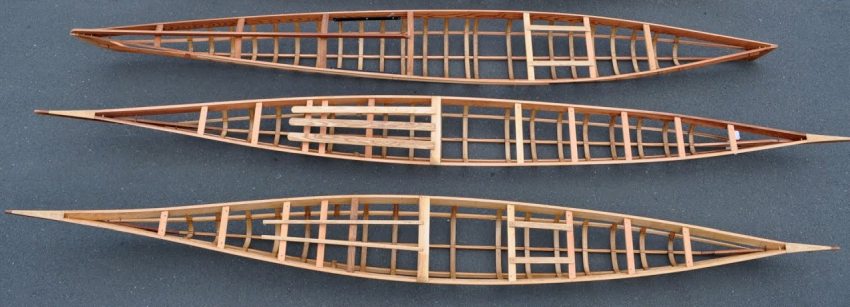
The original kayaks were designed as skin-on-frame boats. Stretching skin, or more recently a treated nylon material, over the framework for a kayak, will give you an extremely lightweight and traditional feeling kayak.
Modern skin-on-frame kayaks have gone high-tech. Some even have a folding frame, which can fit in the trunk of the car, slots together to create a rigid structure to stretch your skin over. This gives you a kayak that is easy to store and lightweight to paddle.
Wooden Kayaks
Wooden kayaks are rare and are often homemade from kits. These kayaks are beautiful pieces of engineering, though they aren’t often used practically anymore. Wooden kayaks can be lightweight and feel responsive but are damaged easily on rocks and beaches.
How is the kayak propelled? Paddle, pedal or motor?
Remember earlier when we said that kayaks are traditionally paddled with a two-bladed paddle? However, there have been some developments in recent years.
Paddle-Propelled Kayaks
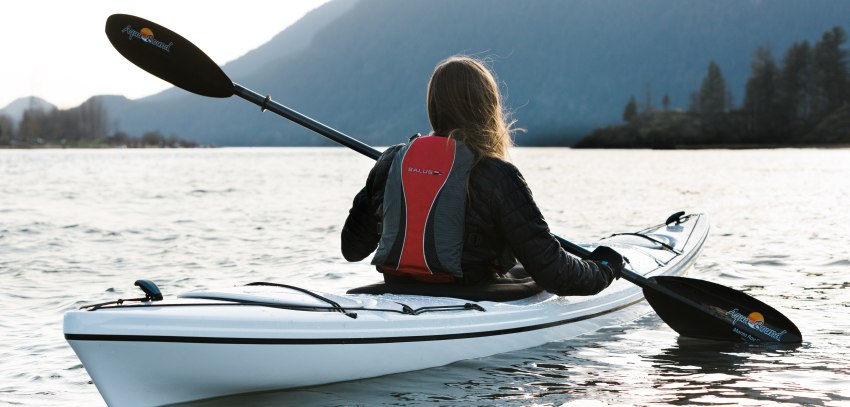
Your paddle is your best friend on the water and the second most important piece of equipment, after your PFD. No matter how you plan to propel your kayak, you should always have a paddle with you.
Paddles come in almost as many shapes, sizes, and material, as kayaks. As with kayaks, plastic, wood, fiberglass and carbon elements of paddles come with different price tags, stiffness and response. They also have different durability.
Paddle blades come in high and low angle, depending on your preferred style of kayaking. They are also available in two, three, or four piece splits. This means that you can easily stow and store your paddle, perfect if you want to carry it as a spare.
Pedal-Powered Kayaks
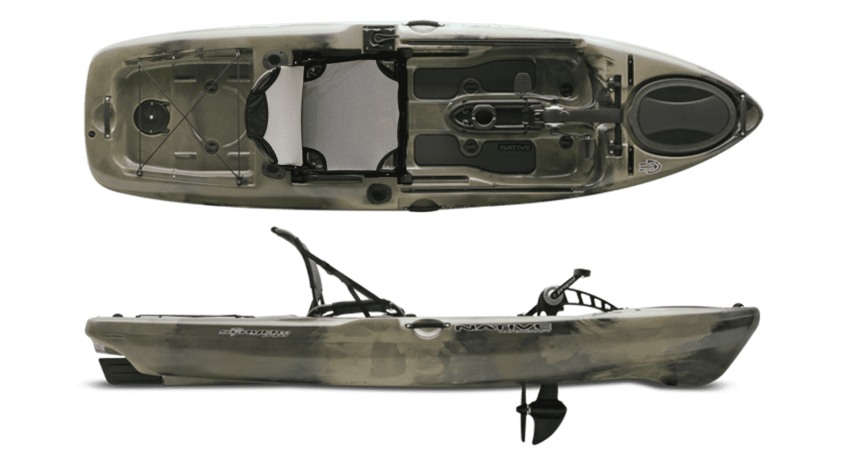
Pedal-powered kayaks have come a long way in recent years. The pedal systems are now efficient and almost effortless, rather than being clunky and cumbersome to carry. Most pedal systems now fold away, too, and there are usually hand-operated rudder systems in the kayak too.
Pedal-powered kayaks are popular options for hunters, anglers, and photographers, who benefit from the ability to go hands-free.
We have an overview of the top pedal kayaks here.
Motorized Kayaks
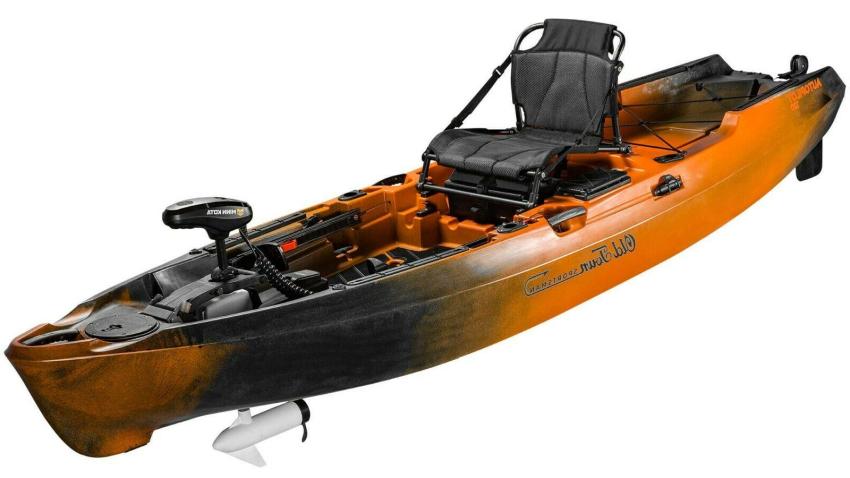
You might argue that once you attach a motor, your kayak might become a boat. If you’re loaded up for a fishing or hunting trip, though, paddling can be exhausting. If you want to conserve energy to fish, motoring your way to your favorite spot makes a lot of sense.
Many kayaks, usually fishing or hunting models, have transoms to attach your motor. These are usually at the stern and sometime the bow. There are also kayak motors which attach at the side of your boat.
Stern motors are usually the largest motors, used to move the kayak between locations. These are usually electric, but some larger kayaks can take gas powered outboard motors too.
Bow mounted motors give you precise steering and control of your kayak and are often used to get your kayak into tight fishing spots. These trolling motors are also effective for holding your kayak in position against a current while you fish.
Side mounted motors are less commonly used, but are an effective way to move your kayak. These side mounted motors let you steer your boat from the motor itself, rather than through a rudder system. If you only intend to use your motor occasionally, a side mounted motor may be more suitable.
RELATED: Best Motorized Kayaks.
What is the intended use of your kayak?
Now that we’ve looked at all the different factors that affect kayak design, we can get into what the different types of kayak are.
Recreational Kayaks
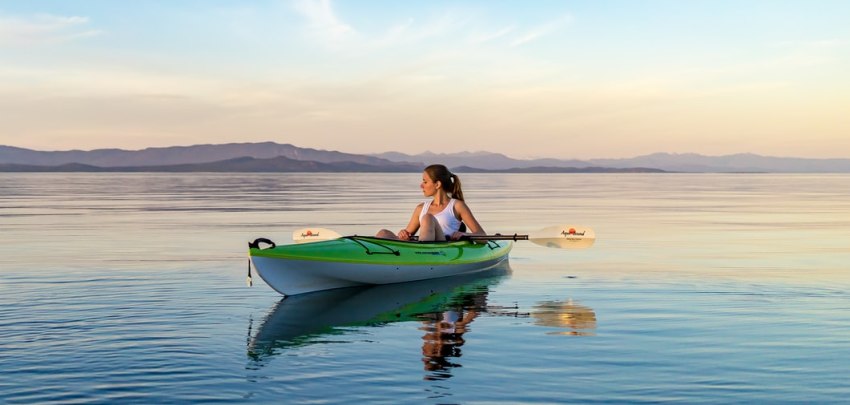
Recreational kayaking is the most popular discipline in the sport. Any kayak which doesn’t specialize in a particular style of water is classified as being recreational. These are usually capable in a range of calm waters, from rivers to lakes and even some ocean surf.
These recreational kayaks are designed for their stability and ease. They often have a balance of v-shape hulls and a keel line to keep them tracking. Recreational kayaks balance length and width to be easy to transport, comfortable to paddle, and fast enough to explore in.
Most inflatables and sit-on-tops fall into the recreational category. Recreational sit-in kayaks often have large cockpits for easy access and confidence that you will exit the kayak easily. Although they’re usually light on features, some recreational kayaks will have simple angling, white water, or touring features.
Touring Kayaks
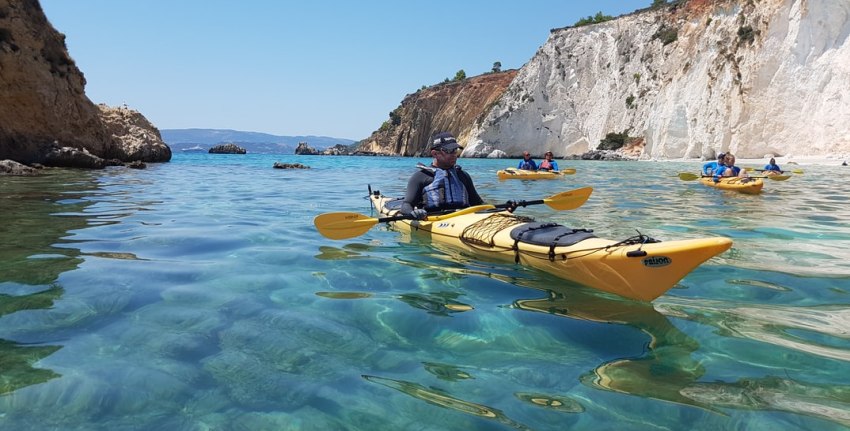
Touring kayaks are a step away from recreational kayaks, but probably their closest cousin. These kayaks are longer than recreational kayaks, usually between 12 and 20 feet long. These boats are built to cover the ground quickly in calm water.
Touring kayaks have a v-shape at the bow and stern of the kayak which helps them track and often have a drop-down skeg, too. Often they have a flat spot in the middle of the boat, which raises the primary stability of the kayak, so you can stop and enjoy your surroundings comfortably.
Most touring kayaks have some storage and deck lines on the top. They vary between styles as to whether they are designed for a single day or multi-day trip. The storage hatches are usually separated by bulkheads, designed to keep water from flooding the whole kayak in the event of a capsize.
Sea Kayaks
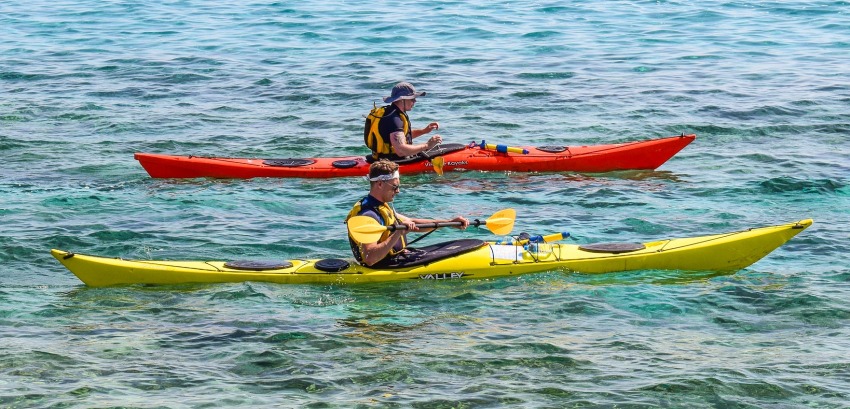
Sea kayaks are designed to go further and faster than touring kayaks. The v-shaped hull runs the length of the kayak which gives it a sleek waterline and top-end tracking. It also means that sea kayaks rely heavily on secondary stability, rather than primary stability.
Compared to the flat hulls of touring kayaks, sea kayaks often have a little rocker at the bow to cut through the waves and rise above the swell. Internally, these kayaks have multiple storage hatches, separated with bulkheads that keep your equipment dry in the event of a capsize. Sea kayaks also have deck lines, for storage and rescues.
Check out our overview of the top rated sea kayaks.
Fishing Kayaks
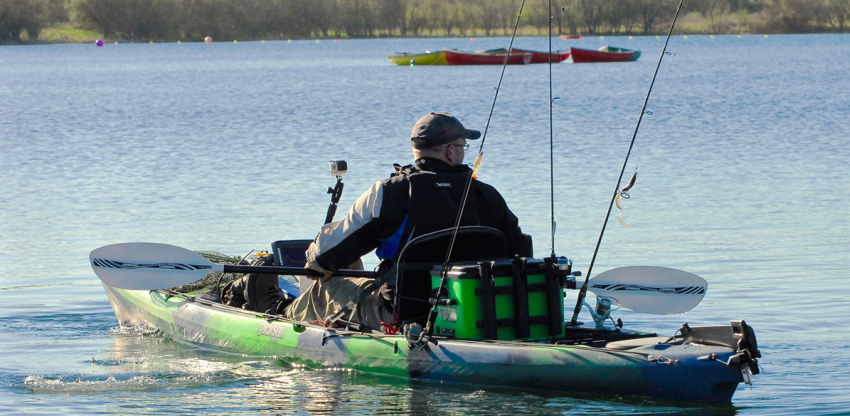
If you’re going after a big catch, you need a stable platform to haul it onto. Fishing kayaks are usually long and wide, with a huge capacity for all of your equipment. Most fishing kayaks are designed so that you can stand to fish without fear of falling in, with open decks and grippy padding on the floor.
As well as relying on their capacity and size for stability, fishing kayaks often come with a variety of sport-specific features. These include rod holders, fish finder mounts and storage well, as well as specific storage for tackle boxes and crates.
If you’re heading out fo the day to fish, you need to be comfortable. Most fishing kayaks come with the most supportive framed seats on the market. Many of these are raised off the deck of the kayak, optimising your fishing position, with some models able to spin or fold away.
Fishing kayaks with all these features don’t come without the associated weight. Lifting your kayak from the roof of your car can be difficult and most anglers will use a trolley to get to the water.
Don’t miss our huge post about the best fishing kayaks.
Hunting Kayaks
Hunting kayaks are similar to fishing kayaks, but tend to be less laden with features. Hunting kayaks rely on enormous level of stability and open deck design for you to comfortably shoot from.
Unlike fishing kayaks, hunting kayaks are usually camouflaged to help you silently sneak up on your hunt. They will have large storage areas onboard, so you can store the fowl you have already shot without impacting on your stability.
We’ve reviewed some great duck-hunting kayaks here.
Whitewater Kayaks
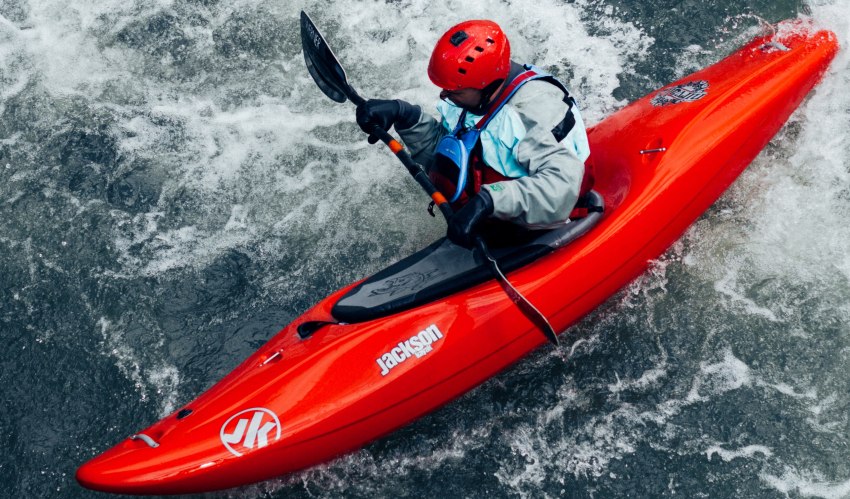
White water kayaks are the shortest kayaks on the market. There is a range of styles specific to styles of white water.
River running
River runner kayaks are designed for all-around use and are the most generalized style of white water kayak. These kayaks are around 7 – 9 feet long and feature flat hulls with a little rocker. They tend to have mid-range volume, designed to be a do-it-all style white water kayak.
Freestyle
Freestyle kayaks, or playboats, measure up to around 6 feet long. These kayaks have short and wide stature and vary in volume. Different styles of playboats are designed for different freestyle moves and have the volume in certain areas depending on their purpose.
These kayaks are at home on waves and in holes, throwing cartwheels and front loops. Their planing hulls mean they’re slow when they’re not surfing. Freestyle kayaks are not designed to paddle any long distances.
Creeking
Measuring between 7 – 9 feet, with rounded hulls and huge rocker profiles, creek kayaks are built to run steep water and big drops. The rocker profile and rounded top decks let these boats resurface efficiently and carry speed out of drops and big features.
Creek boats are rounded and forgiving, with high levels of secondary stability. However, these kayaks require an active paddler to get the best out of them. They don’t tend to suit those starting out in white water and can be frustrating to learn in.
Looking for the best whitewater kayak? Check out this post.
SUP Kayak Hybrids
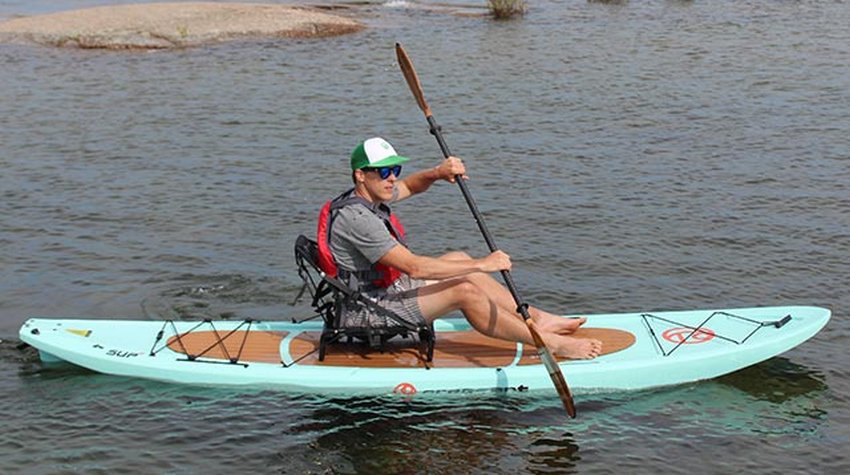
SUP kayak crossovers are a relatively new concept, which have mainly been used for kayak angling. These wide, stable boards are fitted with optional seats and extra storage but stay as an open and stable platform to fish from.
Crossovers/Hybrids
Speaking of a crossover, there are plenty of hybrid kayaks on the market. The styles we have mentioned are the key disciplines of kayaking, but the lines have been blurred just about everywhere.
If you want a touring kayak with white water capabilities or an inflatable angler, then you’re in luck. Crossovers between most reasonable disciplines are available, but of course, you won’t find a marathon kayak that doubles as a fishing platform.
These crossovers are something of a jack of all trades, master of none. While they will let you get out in a variety of conditions, they won’t excel in them when compared to discipline-specific kayaks.
Competition Kayaks
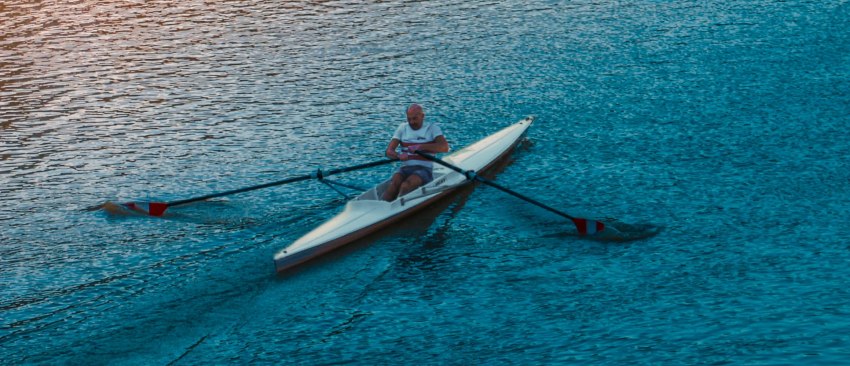
Competitive kayaking has four main disciplines, three of which go all the way up to Olympic level. These competition kayaks are usually built from fiberglass or composite materials, focusing on weight saving and rigid responsiveness, over strength.
All of these kayaks are designed with specific purposes in mind. Unless you’re looking to get into these competitive disciplines, you’re not going to want these boats. They are not going to offer the relaxing experience of a recreational kayak.
Marathon
A little like the running events, marathon kayaking involves covering long distances as fast as possible. These kayaks are long and lightweight, with courses often involving portaging around canal lock gates or weirs.
Marathon kayaks are no-frills, carrying no extra weight than is necessary. They are usually paddled without spray skirts so that the paddler doesn’t overheat as they push themselves.
Sprint
The kayaks look similar to marathon kayaks but have a lower profile in the water. These kayaks are short-distance sprinters, built to gain top speed as quickly as possible and race to the finish line. Sprint kayaks are extremely narrow and rely almost entirely on secondary stability.
Slalom
Chasing down white water, hitting gates, and making decisive moves requires a boat that can not only carry speed but be precise as it does so.
The rounded, bullet-style front end of a slalom kayak is fast over the water and punches through features. A flattened tail at the stern allows the paddler to dip the back end and make tight, pirouetting turns on the spot, before speeding off downstream.
White Water Racing
White water racers look as though someone has stuck wings onto a marathon kayak. These wings deflect water from around the back end of the kayak to increase stability and prevent unwanted capsizes.
White water racing kayaks are long and narrow, designed to get from the top to the bottom of the river as quickly as possible, without doing anything along the way. Because of their narrow build and v-shaped hull, white water racers rely almost entirely on secondary, dynamic stability.
Surfing Kayaks

Surf kayaks have a flat hull, designed to plane on the face of a wave. These kayaks have a small amount of rocker, which prevents them from plowing through a wave while allowing the paddler to initiate a carving turn. The limited rocker profile gives surf kayaks a longer waterline so they can carry more speed.
The flat hull and sharp edges of a surf kayak mean that while they have good primary stability, the secondary stability is limited. These kayaks are built to carve at high speeds down the face of a wave, not sit comfortably on edge on flat water.
Surf Ski
Surf Skis are a sit-on-top version of a surf kayak which unsurprisingly look a lot like a surf-board. These surf skis often have basic but connective seating, as well as thigh straps, to give you as much control as possible.
Types of kayak and their uses, a recap
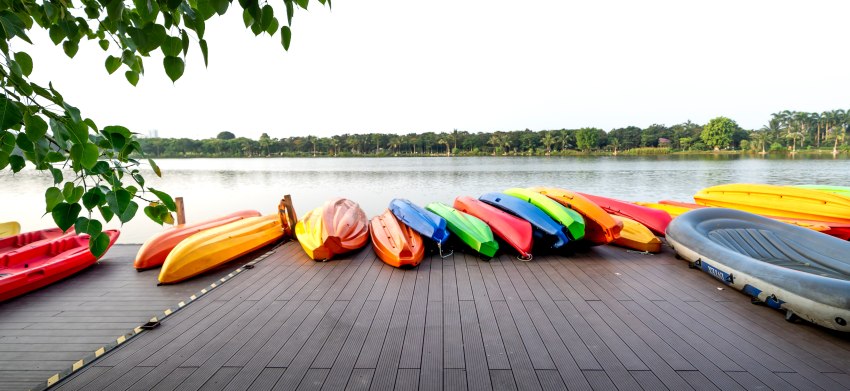
Before you head off to pick your perfect kayak, let’s recap all the elements that affect your choice.
The dimensions of your kayak matter for your chosen environment. Length, width, volume, weight, rocker, edges, chines, and hull shape all impact how your kayak will perform.
Deciding between a sit-on-top or sit-in kayak is one of the most important decisions to make early on. Do you want stability and easy access, or warmth and protection from waves and wind?
How many paddlers need to fit in your kayak? Solo, tandem or tandem+?
What material do you want your kayak to be made from? Inflatable, hard shelled plastic, or composite materials?
How is your kayak propelled? Will you use a paddle, pedal or motor?
What is your intended environment for your kayak? Recreational, touring, sea kayaking, fishing, hunting, white water, surfing or competition kayaks all have different elements. Crossover kayaks blur the lines between some of these disciplines.

